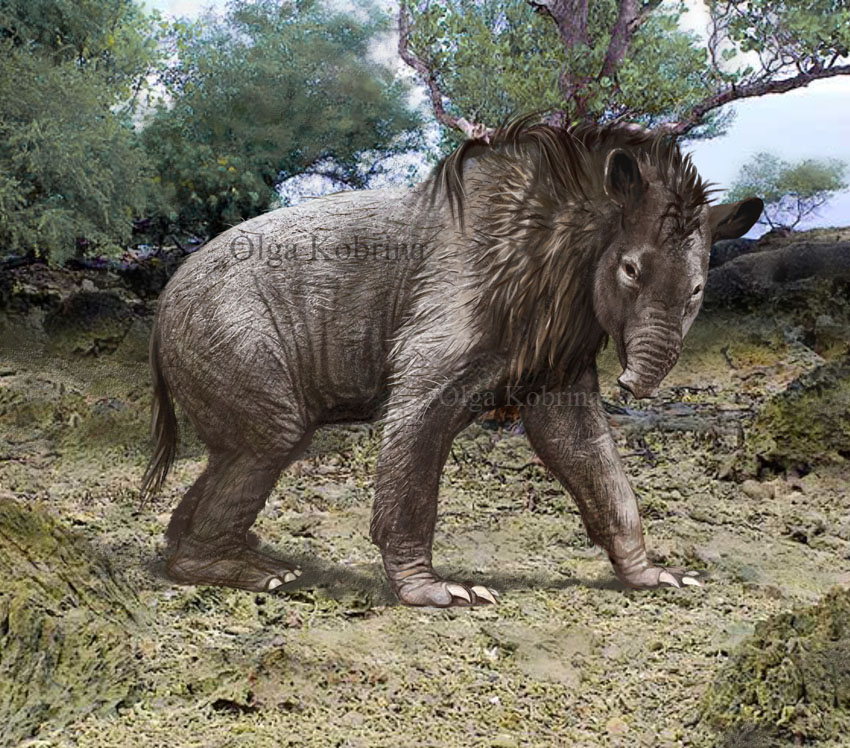Post by Infinity Blade on Apr 11, 2015 4:04:24 GMT 5
Homalodotherium cunninghanni

© @ olllga81
Temporal range: Early to middle Miocene
Scientific classification:
Domain: Eukaryota
(unranked): Unikonta
(unranked): Opisthokonta
(unranked): Holozoa
(unranked): Filozoa
Kingdom: Animalia
Subkingdom: Eumetazoa
(unranked): Bilateria
Superphylum: Deuterostomia
Phylum: Chordata
Infraphylum: Gnathostomata
Clade: Eugnathostomata
Clade: Teleostomi
Superclass: Tetrapoda
Clade: Reptiliomorpha
Clade: Amniota
Clade: Synapsida
Clade: Eupelycosauria
Clade: Sphenacodontia
Clade: Sphenacodontoidea
Order: Therapsida
Suborder: Cynodontia
Clade: Prozostrodontia
Clade: Mammaliaformes
Class: Mammalia
Legion: Cladotheria
Sublegion: Zatheria
Infralegion: Tribosphenida
Subclass: Theria
Clade: Eutheria
Infraclass: Placentalia
Subcohort: Exafroplacentalia
Subcohort: Exafroplacentalia
Magnorder: Boreoeutheria
Superorder: Laurasiatheria
(unranked): †Meridiungulata
Order: †Notoungulata
Suborder: †Toxodonta
Family: †Homalodotheriidae
Genus: †Homalodotherium
Species: †H. cunninghanni
Homalodotherium cunninghanni is an extinct species of herbivorous notoungulate that lived in South America from the early to middle Miocene. Elmer S. Riggs stated that the manus were digitigrade and the pes were plantigrade. Given the morphology of the humerus and the well-developed and elongated deltoid region, the shoulders must have possessed a great sum of strength. The forelimbs and manus had a substantial freedom of movement; given this and the useful clavicle along with the fact that the manus possessed claws instead of hooves, Riggs concluded that Homalodotherium must have used its forelimbs to grasp tree branches for feeding or for fossorial habits.[1] Homalodotherium seems to have been convergent with animals such as chalicotheres, ground sloths, therizinosaurs, etc.
References:
[1] Elmer S. Riggs (1937). Mounted skeleton of Homalodotherium.

© @ olllga81
Temporal range: Early to middle Miocene
Scientific classification:
Domain: Eukaryota
(unranked): Unikonta
(unranked): Opisthokonta
(unranked): Holozoa
(unranked): Filozoa
Kingdom: Animalia
Subkingdom: Eumetazoa
(unranked): Bilateria
Superphylum: Deuterostomia
Phylum: Chordata
Infraphylum: Gnathostomata
Clade: Eugnathostomata
Clade: Teleostomi
Superclass: Tetrapoda
Clade: Reptiliomorpha
Clade: Amniota
Clade: Synapsida
Clade: Eupelycosauria
Clade: Sphenacodontia
Clade: Sphenacodontoidea
Order: Therapsida
Suborder: Cynodontia
Clade: Prozostrodontia
Clade: Mammaliaformes
Class: Mammalia
Legion: Cladotheria
Sublegion: Zatheria
Infralegion: Tribosphenida
Subclass: Theria
Clade: Eutheria
Infraclass: Placentalia
Subcohort: Exafroplacentalia
Subcohort: Exafroplacentalia
Magnorder: Boreoeutheria
Superorder: Laurasiatheria
(unranked): †Meridiungulata
Order: †Notoungulata
Suborder: †Toxodonta
Family: †Homalodotheriidae
Genus: †Homalodotherium
Species: †H. cunninghanni
Homalodotherium cunninghanni is an extinct species of herbivorous notoungulate that lived in South America from the early to middle Miocene. Elmer S. Riggs stated that the manus were digitigrade and the pes were plantigrade. Given the morphology of the humerus and the well-developed and elongated deltoid region, the shoulders must have possessed a great sum of strength. The forelimbs and manus had a substantial freedom of movement; given this and the useful clavicle along with the fact that the manus possessed claws instead of hooves, Riggs concluded that Homalodotherium must have used its forelimbs to grasp tree branches for feeding or for fossorial habits.[1] Homalodotherium seems to have been convergent with animals such as chalicotheres, ground sloths, therizinosaurs, etc.
References:
[1] Elmer S. Riggs (1937). Mounted skeleton of Homalodotherium.



